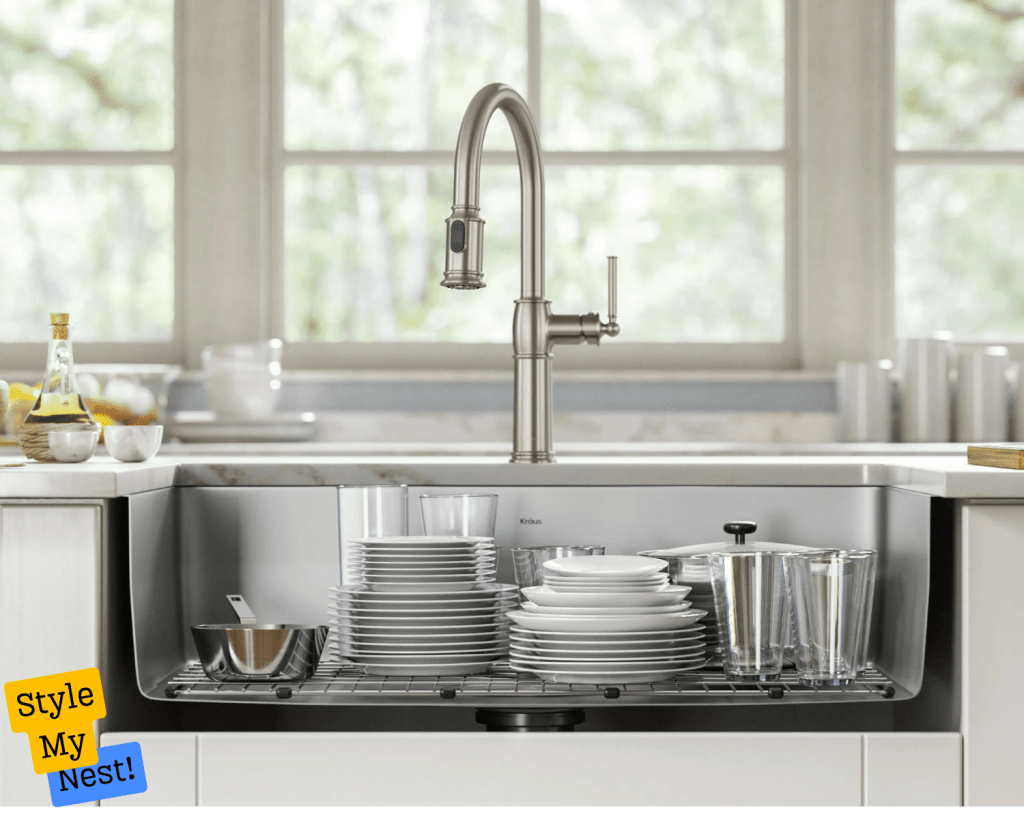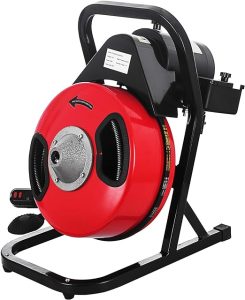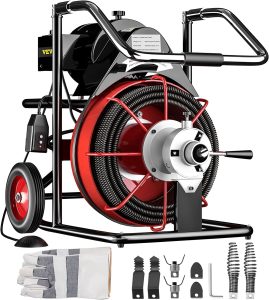Maintaining a clean kitchen sink drain is not just about keeping an essential part of your home looking good; it’s about ensuring the health and safety of your kitchen environment. Not only is it annoying when your washbasin drain becomes clogged or stinky, but it also provides a perfect environment for bacteria that can cause illness.
Discover the hidden secrets to maintaining a spick and span kitchen sink with absolute ease. This extensive manual will reveal the essential methods that guarantee a clean and odour-free washbasin drain, resulting in a sanitary kitchen.
Enhance your cleaning regimen by acquiring the skills to effectively address your kitchen sink drain with expertise. Bid farewell to persistent blockages and unattractive accumulation, and embrace the revitalization of your intelligent kitchen sink. Using our proven techniques, you may quickly drain your washbasin to its former condition.

Understanding Your Kitchen Sink Drain
Your kitchen sink drain might seem simple at first glance, but it’s a complex assembly designed to prevent clogs and sewer gases from entering your home. The essential elements comprise the strainer, the garbage disposal (if applicable), the trap (often a P-trap), and the drainpipe. Every component plays a crucial part in the overall functionality of the drainage system.
Here’s a brief overview with simple explanations:
Sink Basin: The part of the sink that holds water and where you wash dishes.
Drain Hole: Located at the bottom of the sink basin, water exits the sink.
Strainer or Basket Strainer: Sits inside the drain hole to catch food particles and prevent them from clogging the pipes. The item can be simply detached for cleaning.
Stopper: A device designed to prevent water from flowing out, particularly handy for soaking dishes.
Tailpiece: The tailpiece is a vertical pipe directly beneath the strainer. It serves as a connection between the washbasin and the remaining components of the drainage system.
P-Trap: A curved pipe piece that maintains a constant presence of water, effectively blocking the entry of sewer gases into your home via the washbasin. It is called such because its form resembles the letter “P.”
The drain pipe is responsible for transporting wastewater from the P-trap to the main drain line in your home.
Cleanout: In certain systems, a cleanout section may be present in either the P-trap or the drain pipe. This feature facilitates the clearance of blockages by providing simpler access.
Why Regular Cleaning Is Crucial
Ignoring your kitchen sink drain can lead to food particles, grease, and other debris buildup, resulting in clogs and odors. Regular cleaning prevents these issues, saving you time and money on potential plumbing emergencies. Plus, it contributes to a healthier kitchen environment.
Preparing to Clean Your Kitchen Sink Drain
Tools and Materials You Will Need
- Baking soda: For deodorizing and scrubbing.
- White vinegar: To dissolve buildup and disinfect.
- Hot water: Essential for flushing and cleaning.
- Dish soap: Grease-cutting and cleaning agent.
- Plunger: To remove stubborn clogs.
- Old toothbrush: For scrubbing hard-to-reach areas.
- Soft cloth or sponge: For wiping surfaces clean.
- Rubber gloves: To protect your hands.
- Small brush or pipe cleaner: For detailed cleaning.
Safety First: Precautions to Take
When using boiling water or chemical cleaners, protect your skin and eyes. Always follow the instructions on commercial cleaners to avoid damaging your pipes or harming yourself.

Step-by-Step Guide to unclog Your Kitchen Sink Drain
Daily Maintenance Tips
Start with simple habits like running hot water down the drain after each use and using a sink strainer to catch food particles. These small steps can significantly reduce the risk of clogs.
The Baking Soda and Vinegar Method
This eco-friendly method involves pouring a cup of baking soda followed by a cup of white vinegar down the drain. Cover the drain, wait 15 minutes, then flush with boiling water. The chemical reaction helps break down fatty acids, allowing them to be flushed away.
Boiling Water Technique
Regularly pouring boiling water down the drain can help melt and dislodge grease buildup. However, use this method cautiously if you have PVC pipes, as the high temperature can loosen the pipe joints.
Using a Plunger
A plunger can dislodge clogs that are close to the drain’s surface. Ensure you have a tight seal around the drain opening and plunge vigorously several times.
Chemical Cleaners: Pros and Cons
While chemical cleaners offer a quick solution, they can be harsh on your plumbing and the environment. Reserve these for tough clogs and use them sparingly.
Snaking the Drain
A plumber’s snake can navigate the pipes to break up or retrieve obstructions for deeper clogs. It’s a more invasive method but highly effective for serious blockages.

Advanced Cleaning and Maintenance
Automated Drain Cleaners:
Imagine a device similar to a programmable soap dispenser but for your drain. A product like “ SHZOND Drain Cleaning Machine” could automatically release eco-friendly cleaning agents into your sink drain every night to break down fats, oils, and grease, preventing clogs before they start.
High-Pressure Drain Blasters:
Think of a device akin to a power washer designed for your pipes, such as “VEVOR 100FT x 1/2 Inch Drain Cleaning Machine“ This tool could use water pressure to clear blockages deep within your plumbing, offering a more effective solution than traditional plungers.
Ultrasonic Cleaning Devices:
Envision a gadget like “Ultrasonic Dishwasher with Transformer” which uses ultrasonic waves to agitate and break down tough grime and buildup on a microscopic level, keeping your drain pipes clear without harsh chemicals.
Enzyme Drain Cleaners:
Products such as “ Green Gobbler Enzyme Drain Cleaner” use natural enzymes and bacteria to safely digest organic debris in your pipes, maintaining clear drains and reducing odours with an environmentally friendly approach.
Drain Inspection Cameras:
Tools like “ Anysun Sewer Camera with 512Hz Sonde Transmitter” allow you to explore the inside of your pipes with a small, waterproof camera, helping to pinpoint clogs, cracks, or buildup and tailor your cleaning approach accordingly.
Maintenance Software:
A digital platform, “SinkSmart Scheduler,” could help you keep track of cleaning schedules, remind you when it’s time for maintenance, and even alert you to potential issues based on smart drain monitoring technology.
Detaching and Cleaning the P-Trap
Removing and cleaning the P-trap under your sink can directly remove clogs. This process involves unscrewing the P-trap and clearing out any debris trapped inside.
Professional Drain Cleaning Services
When home remedies fail, or if you’re dealing with recurrent clogs, it might be time to call the professionals. They can perform a thorough cleaning and inspection to ensure your plumbing is in top condition.
Here’s a brief overview of a few top contenders:
Roto-Rooter: Known for its wide availability nationwide, Roto-Rooter offers 24/7 emergency services and a broad range of plumbing and drain cleaning solutions. Their extensive network and decades of experience make them a go-to for many homeowners and businesses.
Mr. Rooter Plumbing: Part of the Neighborly family of home service brands, Mr. Rooter Plumbing is known for its customer service, providing upfront pricing without overtime charges. Their commitment to quality and professionalism makes them a popular choice.
Benjamin Franklin Plumbing: Famous for their punctuality promise (“If there’s any delay, it’s you we pay!”), Benjamin Franklin Plumbing offers a wide range of plumbing services, including effective drain cleaning and maintenance programs.
ServiceMaster Restore: While primarily focused on restoration services, ServiceMaster Restore also provides emergency plumbing and drain services. They are particularly valuable when plumbing issues have led to water damage.
Natural Remedies for a Fresh-Smelling Sink
A mix of lemon peels and cold water running through the garbage disposal can naturally freshen your drain. Regular use of baking soda and vinegar can also maintain a clean, odour-free sink.
Best Practices for Sink Usage
Avoid pouring grease and oil down the drain, dispose of coffee grounds and food scraps in the trash or compost, and run cold water when using the garbage disposal. These practices will keep your sink running smoothly.
A Stitch in Time Saves Nine
Keeping your kitchen sink drain clean is an ongoing task, but one that pays off by preventing bigger, more costly issues down the line. Incorporating these cleaning and maintenance tips into your routine ensures your sink remains a clean, functional part of your kitchen. Remember, a little effort goes a long way in maintaining the heart of your home.
FAQ Section
Q: How often should I clean my kitchen sink drain?
A: For best results, perform a basic cleaning with baking soda and vinegar once a month and a deep clean every 3-6 months or as needed based on usage.
Q: Can I use bleach to clean my kitchen sink drain?
A: While bleach can be effective in eliminating bacteria and odours, it’s harsh on your pipes and the environment. It’s better to use more natural, less corrosive solutions.
Q: What should I do if none of these methods clear the clog?
A: If home remedies don’t work, it’s time to consult a professional plumber. Persistent clogs may indicate a deeper issue that requires professional intervention.
Q: Is using a plunger on a sink with a garbage disposal is safe?
A: Yes, but use caution. Ensure the disposal is off, and plunge gently to avoid damaging the disposal’s mechanisms.




